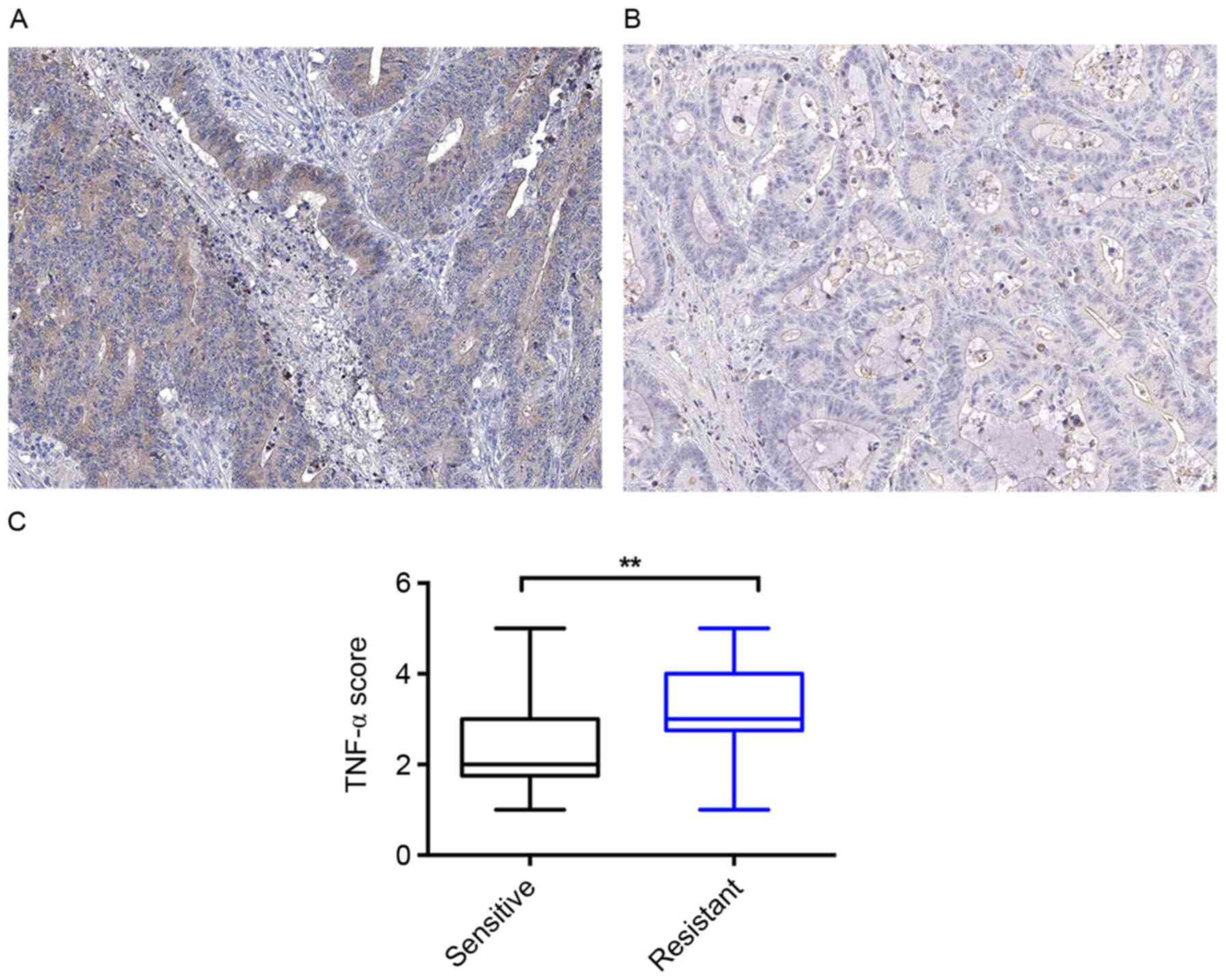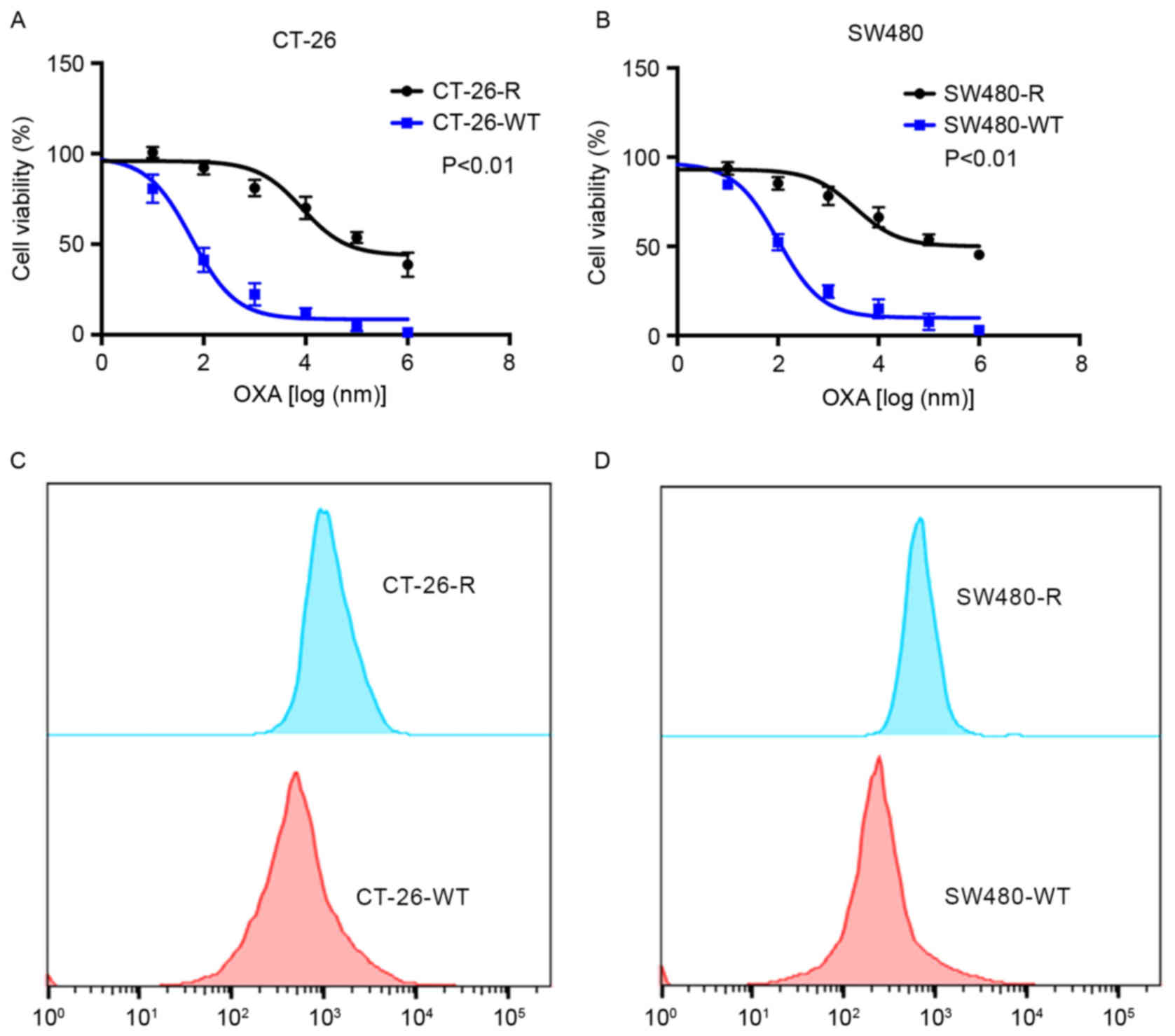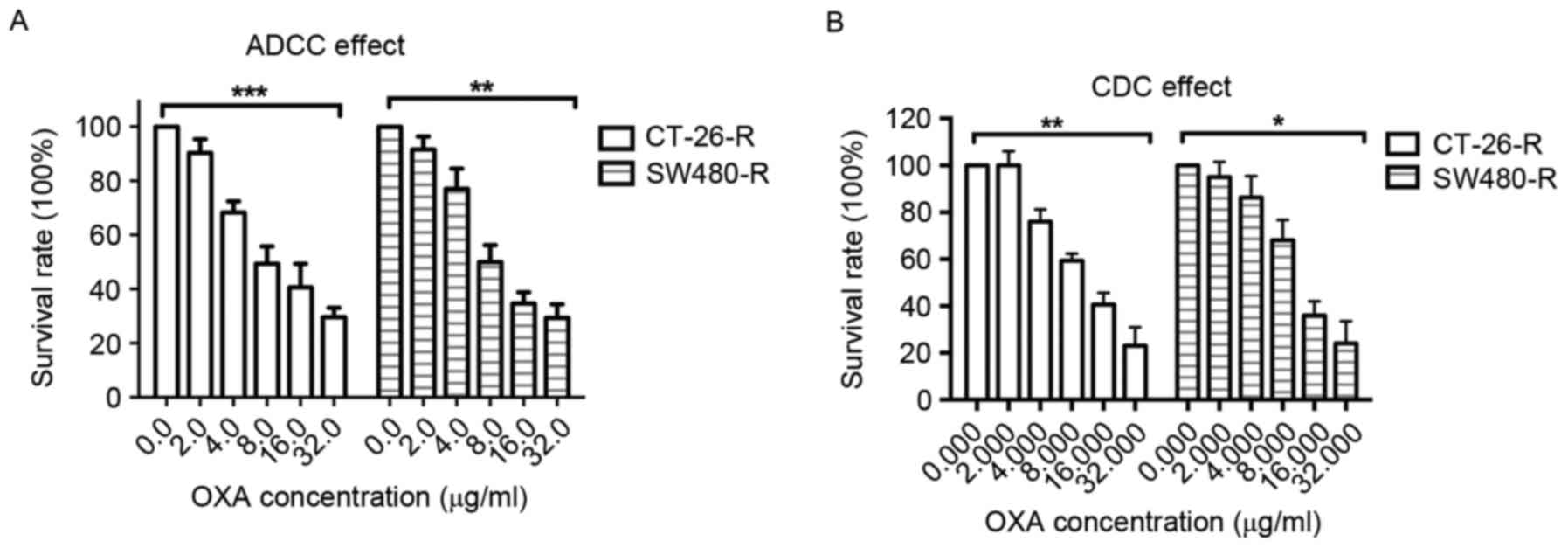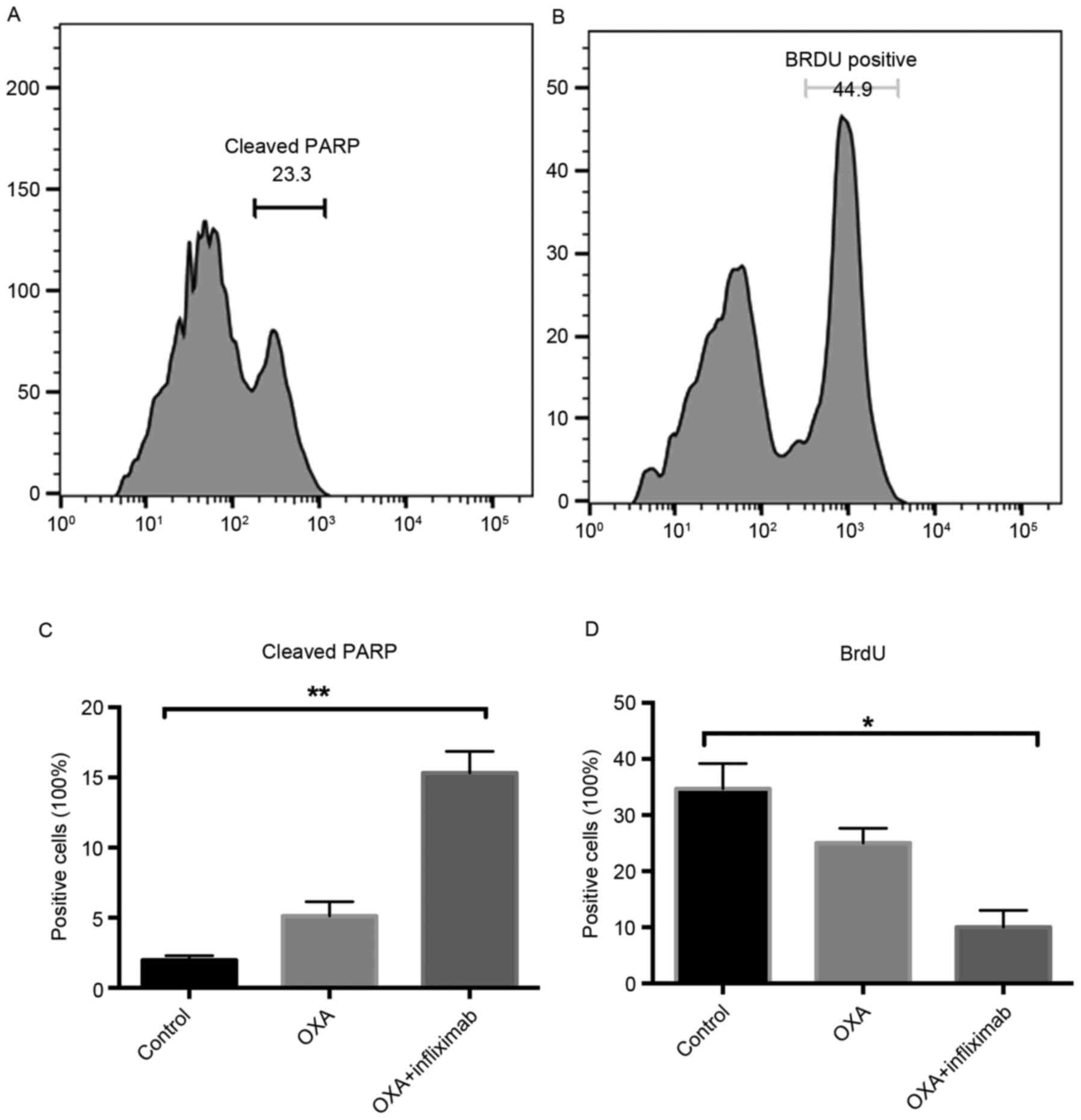Oxaliplatin and infliximab synergize to induce regression of colon cancer
- Authors:
- Published online on: November 22, 2017 https://doi.org/10.3892/ol.2017.7468
- Pages: 1517-1522
-
Copyright: © Huang et al. This is an open access article distributed under the terms of Creative Commons Attribution License.
Abstract
Introduction
Colon cancer has one of the highest mortality rates of any malignant disease globally. According to the annual age-adjusted cancer incidence and mortality rate in the USA from 1975 to 2002, colon and rectal cancer were among the three most frequently diagnosed types of cancer (1). Patients with localized colon cancer and rectal cancer exhibit a high 5-year relative survival rate (>80%); however, cases exhibiting distant metastases have a 5-year relative survival rate of only ~10% (1). Previous studies have demonstrated that palliative chemotherapy is able to extend the median survival time of patients with metastatic colon cancer (2–4). However, a number of distinct effects of chemotherapies were observed among different patients with colon cancer. An increased response rate to treatment and longer continuous effects are required (3,4).
Tumor necrosis factor-α (TNF-α) is an important cytokine produced primarily by activated macrophages and numerous other cells including fibroblasts, natural killer cells and cluster of differentiation (CD)4+ lymphocytes (5,6). TNF-α exhibits multiple functions in mediating systemic inflammation, regulating the immune response, cell metabolism, proliferation and apoptosis (7,8). There are two types of TNF-α receptor (TNFRs) which mediate these complex functions: TNFR1 and TNFR2 (9,10). Previous studies have demonstrated that TNF-α serves roles in promoting the development of a number of malignant tumors, including breast, renal and pancreatic cancer (10–13). Tumor cells themselves are able to produce TNF-α (14). Anti-TNF-α treatment has been studied in a number of these tumors, and favorable effects have been observed (15).
Inflammation is associated with the initiation of colon cancer (16). Colitis-associated cancer, a subtype of colorectal cancer, is associated with inflammatory bowel disease (16). Currently anti-TNF-α treatment is used against a number of inflammatory diseases, including rheumatoid arthritis and Crohn's disease. As TNF-α is a key pro-inflammatory cytokine, it was hypothesized that anti-TNF-α may promote the effects of chemotherapy on patients with colon cancer. In the present study, the effects of combining anti-TNF-α treatment (infliximab) and oxaliplatin (OXA) on colon cancer were explored in an animal model.
Materials and methods
Cell culture and cell line establishment
Human colon cancer cell line SW480 and murine colon cancer cell line CT-26 (American Type Culture Collection, Manassas, VA, USA) were cultured with RPMI-1640 medium (Thermo Fisher Scientific, Inc., Waltham, MA, USA) supplemented with 10% fetal bovine serum (FBS; Thermo Fisher Scientific, Inc.) and Leibovitz's L-15 medium (Sigma-Aldrich; Merck KGaA, Darmstadt, Germany) supplemented with 10% FBS, respectively. Additionally, 100 µg/ml streptomycin (Thermo Fisher Scientific, Inc.) and 100 U/ml penicillin (Thermo Fisher Scientific, Inc.) was added to the medium throughout the cell culture. All cells were cultured using a humidified incubator at 37°C with 5% CO2. Cells were subcultured when the cells were 90% confluent. To induce OXA-resistant cell lines, SW480 and CT-26 cell lines were treated with 0.1 µM OXA (Sigma-Aldrich; Merck KGaA) for 1 month to induce drug resistance (culture medium was changed with fresh medium containing OXA every three days). The drug resistance was confirmed using a cell viability assay following treatment with increasing doses of OXA (10 and 1,000 µM). The drug-resistant cells (SW480-R and CT-26-R) were used for further study.
Patient samples
Formalin-fixed paraffin-embedded 4-µm thick colon cancer tissue samples were collected from 60 patients to evaluate their TNF-α expression levels. All patients were diagnosed with colon cancer at the First Affiliated Hospital of Hebei North University between June 2011 and April 2014. Tissue samples were collected during resective surgery. A total of 27 (45.0%) of these patients were female and 33 (55.0%) were male. The mean age of these patients was 52.5 years (range, 46–74 years). The present study was approved by the Local Committee of Medical Research Ethics of the First Affiliated Hospital of Hebei North University (Zhangjiakou, China). Written informed consent was obtained from the patients or their representatives. All tissue samples were collected via surgery prior to the patients receiving chemotherapy. Following surgery, these patients received OXA as adjuvant chemotherapy. The response to OXA treatment was monitored and evaluated by computed tomography scans and X-ray examinations according to the revised RECIST guidelines (version 1.1) (16).
Immunohistochemical staining
The expression levels of TNF-α in the FFPE tissues from the patients with colon cancer were assessed using immunohistochemistry (IHC). Standard IHC procedures were followed (17). Briefly, sample sections were deparaffinized using xylene and blocked by incubating with 3% H2O2 in methanol, followed by rehydration with decreasing concentrations of ethanol. Antigen retrieval was performed by heating the sections with Reveal Decloaker (Biocare Medical, LLC, Paheco, CA, USA) in a microwave for 10 min at 100°C. Primary antibody (anti-TNF-α antibody; 1:100 dilution; cat. no. ab9635; Abcam, Cambridge, MA, USA) was added prior to incubation at 4°C overnight. Secondary antibody (horseradish peroxidase-conjugated; 1:100 dilution; cat. no. ab6721; Abcam) was added prior to incubation for 1 h at room temperature. Then 3,3-diaminobenzidine was added and washed away immediately once the stain had developed. The slides were mounted and observed using light microscopy. Each slide was evaluated by two researchers independently without knowledge of the background information of the slides. TNF-α expression was divided into five levels based on the proportion of positive cells: 5, >80%; 4, >60%; 3, >40%; 2, >20%; 1, <20%.
Cell viability
Cell viability was determined using a Cell Counting Kit-8 (CCK-8) kit (Merck KGaA, Darmstadt, Germany), according to the manufacturer's protocol. Equal numbers of cells (5×104 cells/well) were seeded on 96-well plates containing 100 µl culture medium. Various concentrations of OXA were added to the cells prior to incubation for 48 h. CCK-8 solution (10 µl/well) was added prior to incubation for 30 min at 37°C. Finally, the absorbance at 450 nm was assessed using an MRX microplate reader (Dynex Technologies, Chantilly, VA, USA). The absorbance value of each treated group relative to that of the control group was used to represent the cell viability.
Antibody-dependent cellular cytotoxicity (ADCC) assay and complement-dependent cytotoxicity (CDC) assay
ADCC and CDC assays were performed to evaluate the cytotoxic effects of infliximab on OXA-resistant colon cancer cell lines SW480-R and CT-26-R. Equal numbers of these two cell lines were seeded on 96-well plates (1×105 cells/well) with 100 µl RPMI-1640 medium (Sigma-Aldrich; Merck KGaA). Infliximab (Thermo Fisher Scientific, Inc.) was added prior to incubation for 1 h at 37°C with 5% CO2. Effector cells [macrophages were isolated from Balb/c mice as previously described (18)] were added prior to incubation for another 48 h under identical conditions. For the CDC assay, the effector cells were replaced with guinea pig serum containing mixed active complements (Sigma-Aldrich; Merck KGaA), which were added to the target cells and incubated for 5 h at 37°C with 5% CO2. The complement was replaced with phosphate-buffered saline in the control group. The cell viability was assessed according to the aforementioned protocol.
Animal model
A colon cancer xenograft mouse model was established using the CT-26-R cell line and Balb/c mice (30 females; 20–22 g; 6 weeks of age; Shanghai Experimental Animal Center, Chinese Academy of Science, Shanghai, China). Equal numbers of CT-26-R cells (1×106) were inoculated into the flanks of these mice subcutaneously. At 1 week after the inoculation, the mice were randomly divided into three groups (10 per group) to receive treatments once per week: OXA (4 mg/kg) alone; OXA (4 mg/kg) + infliximab (6 mg/kg); or saline (control). The agents were injected into the tail vein of these mice once a week. The tumor volume (width2 × length × π/6) and survival date was observed and recorded. All mice were raised in a specific pathogen-free environment (at room temperature, with fresh air and a humidity of 40–50%) with a 12-h light/12-h dark cycle and free access to water and food. This animal study was approved by the Experimental Animal Use Committee of the First Affiliated Hospital of Hebei North University.
Fluorescence-activated cell sorter (FACS) analysis
FACS analysis was performed to determine the levels of TNF-α, cleaved poly(ADP-ribose) polymerase (PARP) and bromodeoxyuridine (BrdU) in colon cancer cell lines SW480, SW480-R, CT-26 and CT-26-R or xenograft mouse model-derived tumor cells. Cells were incubated with the following primary antibodies: anti-TNF-α (1:100 dilution; cat. no. ab1793; Abcam) and anti-cleaved PARP (1:100 dilution; cat. no. ab110315; Abcam) for 30 min at room temperature followed by washing with PBS three times. Next, a fluorescence-conjugated secondary antibody (1:1,000 dilution; cat. no. ab6789; Abcam) was added prior to incubation for 20 min at room temperature followed by washing with PBS three times. The cells were then analyzed using a BD FACSCanto™ II machine (BD Biosciences, Franklin Lakes, NJ, USA) and FlowJo software 9.7.1 (FlowJo LLC, Ashland, OR, USA).
Statistics
All statistical analysis and data visualization was performed using GraphPad 7 (GraphPad Software, Inc., La Jolla, CA, USA) or SPSS software 17.0 (SPSS, Inc., Chicago, IL, USA). The difference between means of various experimental groups were analyzed using either Student's t-test or a one-way analysis of variance with Bonferroni's pairwise comparison. Survival analysis was performed using the Kaplan-Meier estimator method. The differences between the survival curves were analyzed using a log-rank test. P<0.05 was considered to indicate a statistically significant difference.
Results
TNF-α is increased in the tumor tissue of patients with OXA-resistant colon cancer and OXA-resistant colon cancer cell lines
A total of 60 tumor tissue samples were collected from patients with colon cancer who accepted OXA treatment following surgery, half of whom exhibited sensitivity to the OXA treatment, with the other half exhibiting resistance to the OXA treatment. These samples were divided into two groups according to their response to the OXA treatment. IHC was performed to evaluate the TNF-α level of these tissue samples. As presented in Fig. 1A and B, these samples expressed distinct levels of TNF-α. Quantitative analysis identified that the patients with colon cancer who were sensitive to the OXA treatment had a lower mean TNF-α level compared with that of the patients who were resistant to the OXA treatment (Fig. 1C).
TNF-α is increased in OXA-resistant colon cancer cell lines
OXA-resistant colon cancer cell lines, CT-26-R and SW480-R, were created using low-dose OXA treatment. As presented in Fig. 2A and B, these cell lines exhibited resistance to increasing concentrations of OXA. The TNF-α expression was measured using FACS analysis (Fig. 2C and D). These cell lines exhibited increased levels of TNF-α compared with the wild-type CT-26 and SW480 cell lines. In summary, the association of TNF-α expression with OXA sensitivity suggests that TNF-α may alter the effect of chemotherapy on patients with colon cancer.
Infliximab inhibits the survival of OXA-resistant colon cancer cell lines by inducing ADCC and CDC effects
Considering that OXA-resistant colon cancer cell lines express increased levels of TNF-α and that TNF-α is an important cytokine which regulates the immune response, the ability of infliximab to induce ADCC and CDC effects on the OXA-resistant colon cancer cell lines CT-26-R and SW480-R was investigated. Notably, it was revealed that infliximab decreased the survival rate of CT-26-R and SW480-R cells in the presence of macrophages or active complement (Fig. 3A and B). These results suggest that TNF-α may promote the resistance of colon cancer cells to OXA treatment by inhibiting any immune response to tumor cells.
Infliximab decreases the resistance to OXA in a colon cancer mouse model
Mice bearing CT-26-R xenograft colon tumors were assigned to three treatment groups: OXA, OXA + infliximab or saline. These mice exhibited different survival rates. The group receiving OXA + infliximab exhibited the longest overall survival time and most marked tumor growth compared with the group receiving OXA alone and the control group (Fig. 4). Notably, an increased level of cleaved PARP was detected in the tumor cells of the mice treated with OXA + nfliximab compared with the OXA group (Fig. 5A and B). Additionally, the BrdU incorporation rate of these tumor cells was decreased compared with that of the tumor cells from the mice receiving OXA (Fig. 5C and D).
Discussion
Although there have been previous studies demonstrating that local administration of TNF-α may inhibit the development of advanced solid tumors, including metastatic liver cancer and soft tissue sarcomas, only a minor effect was observed, dependent on the combination with other antiblastic agents, including doxorubicin and melphalan (6,19,20). Conversely, previous studies have demonstrated that TNF-α may promote the metastasis of tumors (6,21). A previous study has demonstrated that TNF-α-deficient mice were resistant to chemical carcinogenesis (22). These tumor-promoting effects of TNF-α suggest that anti-TNF-α treatment may be beneficial to patients with cancer.
Anti-TNF-α treatment has been utilized previously to treat patients with myelogenous leukemia, multiple myeloma and myelofibrosis (23). There are ongoing clinical trials of anti-TNF-α treatment for other malignances, including ovarian cancer and non-small cell lung cancer (6,7). Additionally, TNF-α-induced protein 3 was demonstrated to inhibit the antitumor activity of CD8+ T cells, which may allow the tumor cells to evade immune surveillance (24). In the present study, it was identified that TNF-α expression was increased in the colon cell lines with induced resistance to OXA treatment. The patients with colon cancer who were resistant to OXA treatment also tended to exhibit increased TNF-α expression levels compared with the patients who were sensitive to OXA treatment. Results of the in vitro study revealed that infliximab induced ADCC and CDC effects, inhibiting the survival of OXA-resistant colon cancer cell lines. In the CT-26-R xenograft mouse model, the combination treatment of infliximab and OXA resulted in improved effects when compared with the OXA treatment alone.
In previous studies, to the best of our knowledge, there was no evidence demonstrating the direct cytotoxicity caused by anti-TNF-α treatment. The present study provided a possible explanation of the tumor-inhibiting effects of anti-TNF-α treatment: Anti-TNF-α treatment may reject tumor cells through immune response-dependent methods, i.e., ADCC and CDC effects. The combination of infliximab and OXA achieved apparent favorable effects in the OXA-resistant colon cancer xenograft mouse model. This suggests that the anti-TNF-α treatment may have increased the sensitivity of colon cancer cells to chemotherapy. Furthermore, increased levels of cleaved PARP and the decreased BrdU incorporation level were also observed in the infliximab- and OXA-treated mice, which suggested that the combining treatment effectively induced apoptosis and inhibited the proliferation of colon cancer cells.
In conclusion, we hypothesize that anti-TNF-α treatment may sensitize colon cancer cells to chemotherapy and thus enhance the efficacy of chemotherapy for the treatment of colon cancer.
Acknowledgements
The present study sponsored by the Excellent Clinical Medicine Talent Program of Finance Department of Hebei Province, 2015: Fundamental and Clinical Research of Gene Detection, Mechanism, Resistance and Accurate Treatment of Colorectal Cancer Cases in Regions of Hebei, Shanxi and Inner Mongolia.
References
|
Jemal A, Siegel R, Ward E, Murray T, Xu J, Smigal C and Thun MJ: Cancer statistics, 2006. CA Cancer J Clin. 56:106–130. 2006. View Article : Google Scholar : PubMed/NCBI | |
|
Jonker DJ, Maroun JA and Kocha W: Survival benefit of chemotherapy in metastatic colorectal cancer: A meta-analysis of randomized controlled trials. Br J Cancer. 82:1789–1794. 2000. View Article : Google Scholar : PubMed/NCBI | |
|
Kohne CH, Cunningham D, Di Costanzo F, Glimelius B, Blijham G, Aranda E, Scheithauer W, Rougier P, Palmer M, Wils J, et al: Clinical determinants of survival in patients with 5-fluorouracil-based treatment for metastatic colorectal cancer: Results of a multivariate analysis of 3825 patients. Ann Oncol. 13:308–317. 2002. View Article : Google Scholar : PubMed/NCBI | |
|
André T, Boni C, Mounedji-Boudiaf L, Navarro M, Tabernero J, Hickish T, Topham C, Zaninelli M, Clingan P, Bridgewater J, et al: Oxaliplatin, fluorouracil, and leucovorin as adjuvant treatment for colon cancer. N Engl J Med. 350:2343–2351. 2004. View Article : Google Scholar : PubMed/NCBI | |
|
Eisenman ST, Gibbons SJ, Verhulst PJ, Cipriani G, Saur D and Farrugia G: Tumor necrosis factor alpha derived from classically activated ‘M1’ macrophages reduces interstitial cell of Cajal numbers. Neurogastroenterol Motil. 29:2017. View Article : Google Scholar : PubMed/NCBI | |
|
Mocellin S, Rossi CR, Pilati P and Nitti D: Tumor necrosis factor, cancer and anticancer therapy. Cytokine Growth Factor Rev. 16:35–53. 2005. View Article : Google Scholar : PubMed/NCBI | |
|
van Horssen R, Ten Hagen TL and Eggermont AM: TNF-alpha in cancer treatment: Molecular insights, antitumor effects, and clinical utility. Oncologist. 11:397–408. 2006. View Article : Google Scholar : PubMed/NCBI | |
|
Wu Y and Zhou BP: TNF-alpha/NF-kappaB/Snail pathway in cancer cell migration and invasion. Br J Cancer. 102:639–644. 2010. View Article : Google Scholar : PubMed/NCBI | |
|
Chen G and Goeddel DV: TNF-R1 signaling: A beautiful pathway. Science. 296:1634–1635. 2002. View Article : Google Scholar : PubMed/NCBI | |
|
Sedger LM and McDermott MF: TNF and TNF-receptors: From mediators of cell death and inflammation to therapeutic giants-past, present and future. Cytokine Growth Factor Rev. 25:453–472. 2014. View Article : Google Scholar : PubMed/NCBI | |
|
Stuelten CH, DaCosta Byfield S, Arany PR, Karpova TS, Stetler-Stevenson WG and Roberts AB: Breast cancer cells induce stromal fibroblasts to express MMP-9 via secretion of TNF-alpha and TGF-beta. J Cell Sci. 118:2143–2153. 2005. View Article : Google Scholar : PubMed/NCBI | |
|
Harrison ML, Obermueller E, Maisey NR, Hoare S, Edmonds K, Li NF, Chao D, Hall K, Lee C, Timotheadou E, et al: Tumor necrosis factor alpha as a new target for renal cell carcinoma: Two sequential phase II trials of infliximab at standard and high dose. J Clin Oncol. 25:4542–4549. 2007. View Article : Google Scholar : PubMed/NCBI | |
|
Ohri CM, Shikotra A, Green RH, Waller DA and Bradding P: Tumour necrosis factor-alpha expression in tumour islets confers a survival advantage in non-small cell lung cancer. BMC Cancer. 10:3232010. View Article : Google Scholar : PubMed/NCBI | |
|
Sethi G, Sung B and Aggarwal BB: TNF: A master switch for inflammation to cancer. Front Biosci. 13:5094–5107. 2008. View Article : Google Scholar : PubMed/NCBI | |
|
Terzic J, Grivennikov S, Karin E and Karin M: Inflammation and colon cancer. Gastroenterology. 138:2101–2114.e5. 2010. View Article : Google Scholar : PubMed/NCBI | |
|
Eisenhauer EA, Therasse P, Bogaerts J, Schwartz LH, Sargent D, Ford R, Dancey J, Arbuck S, Gwyther S, Mooney M, et al: New response evaluation criteria in solid tumours: Revised RECIST guideline (version 1.1). Eur J Cancer. 45:228–247. 2009. View Article : Google Scholar : PubMed/NCBI | |
|
Hamanishi J, Mandai M, Iwasaki M, Okazaki T, Tanaka Y, Yamaguchi K, Higuchi T, Yagi H, Takakura K, Minato N, et al: Programmed cell death 1 ligand 1 and tumor-infiltrating CD8+ T lymphocytes are prognostic factors of human ovarian cancer. Proc Natl Acad Sci USA. 104:pp. 3360–3365. 2007; View Article : Google Scholar : PubMed/NCBI | |
|
Ray A and Dittel BN: Isolation of mouse peritoneal cavity cells. J Vis Exp. pii:14882010. | |
|
Rossi CR, Foletto M, Pilati P, Mocellin S and Lise M: Isolated limb perfusion in locally advanced cutaneous melanoma. Semin Oncol. 29:400–409. 2002. View Article : Google Scholar : PubMed/NCBI | |
|
Christoforidis D, Martinet O, Lejeune FJ and Mosimann F: Isolated liver perfusion for non-resectable liver tumours: A review. Eur J Surg Oncol. 28:875–890. 2002. View Article : Google Scholar : PubMed/NCBI | |
|
Orosz P, Echtenacher B, Falk W, Rüschoff J, Weber D and Männel DN: Enhancement of experimental metastasis by tumor necrosis factor. J Exp Med. 177:1391–1398. 1993. View Article : Google Scholar : PubMed/NCBI | |
|
Suganuma M, Okabe S, Marino MW, Sakai A, Sueoka E and Fujiki H: Essential role of tumor necrosis factor alpha (TNF-alpha) in tumor promotion as revealed by TNF-alpha-deficient mice. Cancer Res. 59:4516–4518. 1999.PubMed/NCBI | |
|
Tsimberidou AM, Waddelow T, Kantarjian HM, Albitar M and Giles FJ: Pilot study of recombinant human soluble tumor necrosis factor (TNF) receptor (p75) fusion protein (TNFR: Fc; Enbrel) in patients with refractory multiple myeloma: Increase in plasma TNF alpha levels during treatment. Leuk Res. 27:375–380. 2003. View Article : Google Scholar : PubMed/NCBI | |
|
Giordano M, Roncagalli R, Bourdely P, Chasson L, Buferne M, Yamasaki S, Beyaert R, van Loo G, Auphan-Anezin N, Schmitt-Verhulst AM and Verdeil G: The tumor necrosis factor alpha-induced protein 3 (TNFAIP3, A20) imposes a brake on antitumor activity of CD8 T cells. Proc Natl Acad Sci USA. 111:pp. 11115–11120. 2014; View Article : Google Scholar : PubMed/NCBI |














